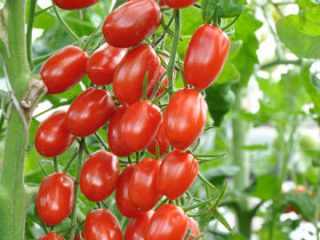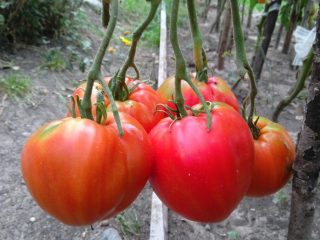Content
Tomato Chocolate Zebra is an exotic mid-season, high-yielding variety. Suitable for cultivation in open ground and under film, withstands Siberian weather conditions. Since the variety is not a hybrid, you can use seeds collected by yourself for planting.
History of origin
The chocolate zebra was bred by the Siberian Garden agricultural company. The brand's products are immune to diseases of the nightshade family, frost-resistant, and can withstand adverse weather conditions. The seeds of the variety first appeared on Russian markets in 2019.
Description of the tomato variety Chocolate Zebra
The variety is mid-season, determinate. The bush reaches a height of 1-1.2 m. The fruits are exotic chocolate brown with yellow-green stripes. The tomatoes are large, flat-round in shape, their weight ranges from 200 to 400 g.If the bush is formed into one stem, then there are specimens up to 600 g.

The pulp of the Chocolate Zebra fruit is dense, sweet and sour, aromatic, granular
Characteristics of the Chocolate Zebra tomato
This variety of tomato can be cultivated both in open ground and in a greenhouse. The bushes need pinching. Chocolate Zebra tomatoes are frost-resistant and suitable for cultivation on an agricultural and industrial scale.
Tomato yield Chocolate Zebra
The first brush is formed above the fifth leaf. In total, a tomato of this variety produces up to six clusters, each of which contains 4-6 tomatoes. From the moment of sowing the seeds until the first harvest is harvested, 115-120 days pass. The yield of one bush is 3 kg.
Resistance to diseases and pests
The Chocolate Zebra variety exhibits resistance to major diseases, provided that agrotechnical standards are met and all preventive measures are taken.
Tomatoes grown in open ground can be favored by spider mites.
How to use
Tomato fruits are suitable for fresh consumption and for preparing salads. It will not be possible to preserve them in their entirety, because they are too large, but sauces, juices and ketchups from this variety of tomatoes are tasty.
Advantages and disadvantages
The Chocolate Zebra variety attracts attention not only with its exotic appearance. It has a number of advantages that outweigh the minor disadvantages noted by experienced gardeners.

Fresh tomatoes can be stored for up to two weeks.
Pros:
- frost resistance;
- high productivity;
- excellent taste;
- resistance to adverse weather conditions and diseases;
- can be grown under film and in open ground;
- the fruits are not prone to cracking.
Minuses:
- the need for stepsoning;
- impossibility of whole-fruit canning.
Features of planting and care
Tomatoes of the Chocolate Zebra variety are recommended to be grown in seedlings. The place should be chosen sunny, not shaded.

Chocolate zebra tomatoes prefer fertile, sandy loam soil
Sowing seeds for seedlings
Sowing of tomato seeds for seedlings is carried out 55-60 days before the expected day of transplantation to a permanent place. To protect plants from disease, pre-sowing treatment of seed material is carried out by soaking it for 20-30 minutes in a solution of potassium permanganate.
Separate glasses, as well as general containers, are suitable for growing seedlings. The container is filled with nutritious soil mixture, and the soil is watered. When the water is absorbed, the seeds are buried. In separate containers, two seeds are sown per hole; in a common container, they are laid out in furrows at a distance of 4 cm from each other. Before the sprouts appear, the container is covered with a transparent film. Approximately two weeks after the seedlings appear, the seedlings are picked.
Transplanting seedlings into the ground
The transplant procedure is carried out after the threat of morning frost has passed. The soil should warm up to +16 °C. In the southern regions this is the first half of May, in the northern regions it is the end of the month or June. Another indicator that it is time to transplant is that the seedlings have reached a height of 30 cm and have 6-7 true leaves.
Allowable number of seedlings per 1 m2 – 3 bushes, row spacing – 50-60 cm.
Watering rules

Watering seedlings is carried out in the morning or evening hours
Use settled water heated in the sun, since the difference in temperature between the air and the liquid can cause shock in the plant. Irrigation is carried out strictly at the root. If water gets on the leaves, it can cause the development of late blight.
Before the fruiting period begins, watering is carried out once a week at the rate of 5 liters of water per bush. After irrigation, it is recommended to mulch the beds. This way the moisture will stay in the soil longer. The procedure is carried out with sawdust or straw. Light-colored mulch reflects sunlight.
Forming tomatoes
The more lateral shoots a bush has, the smaller the harvest. Experienced gardeners advise growing tomatoes of this variety into one or two stems. Stepchildren are not allowed to grow more than 5 cm. It is not advisable to break them out completely; it is recommended to leave a stump up to 1 cm high.
Loosening, weeding, hilling
The soil under the bushes should always be loose. The procedure for saturating the soil with oxygen is carried out after each rain or watering. At a minimum, loosening should be done once every two weeks. It is better to combine the procedure with weeding.

When the bushes grow, they are hilled up
Two procedures are carried out per season. The first hilling is necessary when root buds begin to appear on the stems near the ground. The second procedure is carried out at the moment when the stem below begins to turn blue.
Feeding tomatoes
During the season, tomatoes need to be fed 3-4 times. Recommendations for applying fertilizers:
- The first feeding is carried out two weeks after planting the seedlings. The main condition is that the plants must adapt to the new place and grow. Tomatoes need nitrogen and phosphorus.
- The time for the second feeding occurs two weeks after the first.The plant is fed with phosphorus and nitrogen fertilizers.
- The third procedure is carried out at the height of flowering or at the beginning of fruit growth. Tomato needs phosphorus and potassium.
- The fourth feeding is carried out during the fruiting period. The bushes are fed with potassium and phosphorus fertilizers.
It is recommended to alternate mineral and organic fertilizers.
Pest and disease control
To protect Chocolate Zebra plantings from pests and diseases, planting and crop rotation schemes should be followed, which include:
- pre-sowing soil treatment;
- timely application of fertilizers;
- compliance with watering rules;
- preventing the transmission of diseases through seed material.
Bacterial diseases can be cured using the chemical preparations Fitolavin, Ordan. Pests are eliminated by spraying the bushes with a soap solution made from green or laundry soap.
Conclusion
The Chocolate Zebra tomato is an exotic variety that was bred by Russian breeders of the Siberian Garden agricultural company. The unique taste, ease of care, resistance to diseases and pests were highly appreciated by gardeners who took the risk of cultivating the new variety. A video about the Chocolate Zebra tomato will allow you to appreciate the benefits of the crop.
Reviews from gardeners about the Chocolate Zebra tomato








